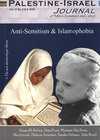Palestine & Palestinians is divided into three main sections. The first provides concise introductory information about geography and history, population and culture, and Jewish colonization. The central and most substantial section is divided into five sub-chapters of tours to Jerusalem, the West Bank, the Gaza Strip, the "Territories of 1948" (Israel) and the occupied Syrian Golan. The final section gives practical information about visas and customs, transportation and communication, national and religious holidays, medical precautions and the media. An appendix complements the book with relevant expressions and phrases in the Palestinian Arabic dialect, a glossary of important terms and a reading list about Palestinian geography, history and society.

Palestine & Palestinians is interspersed with poems and texts from prominent Palestinian writers such as Mu'in Bseiso, Mahmoud Darwish, Ghassan Kanafani, Emile Habibi and Tawfiq Zayyad. It also includes short biographies of important figures such as the noted female activist Hanan Ashrawi; the most popular Palestinian intellectual in the West, the late Edward Said; the pivotal nationalist Khalil Sakakini; and the late President Yasser Arafat. It contains historical maps depicting the various partition plans for Palestine from 1937 to 2000 and maps of the main Palestinian cities. Paintings and color photographs convey the reality of daily life.
There are a few omissions and discrepancies that could be revised for a future edition. The transliterations are made from the spoken Palestinian dialect, not from the written Arabic. This may add to the usefulness of the book in the street, but also takes away from the correct Arabic spelling. Every Palestinian place mentioned is accompanied by a map, but in some instances like East Jerusalem the key to the map is missing. Moreover, while maps depict the proposed partition plans, there is no general map of contemporary Palestine: a larger and more detailed map showing road numbers and more cities would be useful.
While increasing awareness of the Palestinian perspective of the ongoing conflict with Israelis, Palestine & Palestinians manages to transmit a generally objective point of view. In a matter-of-fact manner, it sketches a succinct history from the time of the land of Canaan through the contemporary Palestinian nakba (catastrophe) to the ongoing struggle for national sovereignty; it avoids any broad sweeping political comments about Israeli injustices. The focus on Palestinian culture and tourist travel adds to the book's validity and usefulness for the uninformed foreigner.

